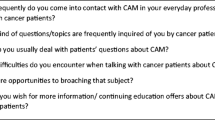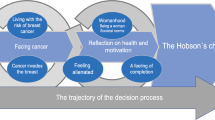Abstract
Goals of work
The purpose of this study was to explore the personal and social processes women with breast cancer engaged in when making decisions about complementary and alternative medicine (CAM). The overall aim was to develop a conceptual model of the treatment decision-making process specific to breast cancer care and CAM that will inform future information and decision support strategies.
Materials and methods
Grounded theory methodology explored the decisions of women with breast cancer using CAM. Semistructured interviews were conducted with 20 women diagnosed with early-stage breast cancer. Following open, axial, and selective coding, the constant comparative method was used to identify key themes in the data and develop a conceptual model of the CAM decision-making process.
Main results
The final decision-making model, Bridging the Gap, was comprised of four core concepts including maximizing choices/minimizing risks, experiencing conflict, gathering and filtering information, and bridging the gap. Women with breast cancer used one of three decision-making styles to address the paradigmatic, informational, and role conflict they experienced as a result of the gap they perceived between conventional care and CAM: (1) taking it one step at a time, (2) playing it safe, and (3) bringing it all together.
Conclusions
Women with breast cancer face conflict and anxiety when making decisions about CAM within a conventional cancer care context. Information and decision support strategies are needed to ensure women are making safe, informed treatment decisions about CAM. The model, Bridging the Gap, provides a conceptual framework for future decision support interventions.

Similar content being viewed by others
References
Ashikaga T, Bosompra K, O’Brien PJ, Nelson L (2002) Use of complementary and alternative medicine by breast cancer patients: prevalence, patterns and communication with physicians. Support Care Cancer 10:542–548
Balneaves LG, Bottorff JL, Hislop TG, Herbert C (2006) Levels of commitment: exploring complementary therapy use by women with breast cancer. J Altern Complement Med 12:459–466
Balneaves LG, Kristjanson LJ, Tataryn D (1999) Beyond convention: describing complementary therapy use by women living with breast cancer. Patient Educ Couns 38:143–153
Balneaves LG, Long B (1999) An embedded decisional model of stress and coping: implications for exploring treatment decision making by women with breast cancer. J Adv Nurs 30:882–892
Barrett B, Marchand L, Scheder J et al (2003) Themes of holism, empowerment, access, and legitimacy define complementary, alternative, and integrative medicine in relation to conventional biomedicine. J Altern Complement Med 9:937–947
Bekker HL, Hewison J, Thornton JG (2003) Understanding why decision aids work: linking process with outcome. Patient Educ Couns 50:323–329
Ben-Arye E, Frenkel M, Margalit RS (2004) Approaching complementary and alternative medicine use in patients with cancer: questions and challenges. J Ambul Care Manage 27:53–62
Blumer H (1969) Symbolic interactionism: perspective and method. University of California Press, Berkeley, CA
Boon H, Brown JB, Gavin A, Kennard MA, Stewart M (1999) Breast cancer survivors’ perceptions of complementary/alternative medicine (CAM): making the decision to use or not to use. Qual Health Res 9:639–653
Boon H, Brown JB, Gavin A, Wardell D (2000) What are the experiences of women with breast cancer as they decide whether to use complementary/alternative medicine. West J Med 173:39
Boon H, Stewart M, Kennard MA et al (2000) Use of complementary/alternative medicine by breast cancer survivors in Ontario: prevalence and perceptions. J Clin Oncol 18:2515–2521
Butow P, Tattersall M (2005) Shared decision making in cancer care. Clin Psychol 9:54–58
Capsi O, Koithan M, Criddle MW (2004) Alternative medicine or “alternative” patients: a qualitative study of patient-oriented decision-making processes with respect to complementary and alternative medicine. Med Decis Mak 24:64–79
Charles C, Whelan T, Gafni A, Reyno L, Redko C (1998) Doing nothing is no choice: lay constructions of treatment decision-making among women with early-stage breast cancer. Sociol Health Illn 20:71–95
Chatwin J, Tovey P (2004) Complementary and alternative medicine (CAM), cancer and group-based action: a critical review of the literature. Eur J Cancer Care 13:210–218
Davison BJ, Gleave ME, Goldenberg SL, Degner LF, Hoffart D, Berkowitz J (2002) Assessing information and decision preferences of men with prostate cancer and their partners. Cancer Nurs 25:42–49
de Lemos ML, John L, Nakashima L, O’Brien RK, Taylor S (2004) Advising cancer patients on natural health products—a structured approach. Ann Pharmacother 38:1406–1411
Eisenberg DM (1997) Advising patients who seek alternative medical therapies. Ann Intern Med 127:61–69
Ernst E, Cohen MH, Stone J (2004) Ethical problems arising in evidence based complementary and alternative medicine. J Med Ethics 30:156–159
Fischer M, Visser A, Voerman B, Garssen B, van Andel G, Bensing J (2006) Treatment decision making in prostate cancer: patients’ participation in complex decisions. Patient Educ Couns 63:308–313
Gerber B, Scholz C, Reimer T, Briese V, Janni W (2006) Complementary and alternative therapeutic approaches in patients with early breast cancer: a systematic review. Breast Cancer Res Treat 95:199–209
Glaser BG, Strauss AL (1967) The discovery of grounded theory: strategies for qualitative research. Aldin, Chicago
Gwede CK, Pow-Sang J, Seigne J et al (2005) Treatment decision-making strategies and influences in patients with localized prostate carcinoma. Cancer 104:1381–1390
Hann D, Baker F, Denniston MM, Entrekin N (2005) Long-term breast cancer survivors’ use of complementary therapies: perceived impact on recovery and prevention of recurrence. Integr Cancer Ther 4:14–20
Hann DM, Baker F, Denniston MM (2003) Oncology professionals’ communication with cancer patients about complementary therapy: a survey. Complement Ther Med 11:184–190
Janis IL, Mann L (1977) Decision making: a psychological analysis of conflict, choice, and commitment. Free, New York
Lazarus RS, Folkman S (1984) Stress, appraisal, and coping. Springer, New York
Lesperance ML, Olivotto IA, Forde N et al (2002) Mega-dose vitamins and minerals in the treatment of non-metastatic breast cancer: an historical cohort study. Breast Cancer Res Treat 76:137–143
O’Connor AM, Jacobsen MJ, Stacey D (2002) An evidence-based approach to managing women’s decisional conflict. JOGN Nurs 31:570–581
Marcus DM, Grollman AP (2002) Botanical medicines—the need for new regulations. N Engl J Med 347:2073–2076
Montbriand MJ (1995) Decision tree model describing alternate health care choices made by oncology patients. Cancer Nurs 18:104–117
O’Connor AM, Fiset V, DeGrasse C et al (1999) Decision aids for patients considering options affecting cancer outcomes: evidence of efficacy and policy implications. J Natl Cancer Inst Monographs 25:67–80
O’Connor AM, Stacey D, Rovner D et al (2001) Decision aids for people facing health treatment or screening decisions. Cochrane Database Syst Rev 2:CD001431
Panel on Definition and Description, of the 1995 Office of Alternative Medicine CAM Research Methodology Conference (1997) Defining and describing complementary and alternative medicine. Altern Ther Health Med 3:49–57
Pierce PF (1993) Deciding on breast cancer treatment: a description of decision behavior. Nurs Res 42:22–28
Reaby LL (1998) The quality and coping patterns of women’s decision-making regarding breast cancer surgery. Psychooncology 7:252–262
Rees RW, Feigel I, Vickers A, Zollman C, McGurk R, Smith C (2000) Prevalence of complementary therapy use by women with breast cancer. A population-based survey. Eur J Cancer 36:1359–1364
Richardson MA, Mâsse LC, Nanny K, Sanders C (2004) Discrepant views of oncologists and cancer patients on complementary/alternative medicine. Support Care Cancer 12:797–804
Roberts CS, Baker F, Hann D et al (2005) Patient-physician communication regarding use of complementary therapies during cancer treatment. J Psychosoc Oncol 23:35–60
Salmenpera L, Suominen T, Vertio H (2003) Physicians’ attitudes towards the use of complementary therapies (CTs) by cancer patients in Finland. Eur J Cancer Care 12:358–364
Slovic P, Fischhoff B, Lichtenstein S (1977) Behavioral decision theory. Annu Rev Psychol 28:1–39
Staples JK, Wilson AT, Pierce B, Gordon JS (2007) Effectiveness of CancerGuides a study of an integrative cancer care training program for health professionals. Integr Cancer Ther 6:14–24
Strauss AL, Corbin JM (1998) Basics of qualitative research: techniques and procedures for developing grounded theory. Sage, Thousand Oaks
Tasaki K, Maskarinec G, Shumay DM, Tatsumura Y, Kakai H (2002) Communication between physicians and cancer patients about complementary and alternative medicine: exploring patients’ perspectives. Psychooncology 11:212–220
Thorne S, Paterson B, Russell C, Schultz A (2002) Complementary/alternative medicine in chronic illness as informed self-care decision making. Int J Nurs Stud 39:671–683
Truant T, Bottorff JL (1999) Decision making related to complementary therapies: a process of regaining control. Patient Educ Couns 38:131–142
Verhoef MJ, White MA (2002) Factors in making the decision to forgo conventional cancer treatment. Cancer Pract 10:201–207
Wallberg BM, H, Nuystedt M, Bolund C, Degner LF, Wilking N (2000) Information needs and preferences for participation in treatment decisions among Swedish breast cancer patients. Acta Oncol 39:467–476
Acknowledgments
The authors would like to kindly acknowledge the women who participated in this study. Funding for this project was received from the Canadian Institutes of Health Research (CIHR) and the Canadian Breast Cancer Research Alliance (CBCRA). A Canadian Cancer Society Research Scientist Award (supported through the NCIC Prostate Cancer Initiative) was also awarded to Dr. Lynda Balneaves. Dr. Marja Verhoef was supported by a Canada Research Chair in Complementary Medicine.
Author information
Authors and Affiliations
Corresponding author
Rights and permissions
About this article
Cite this article
Balneaves, L.G., Truant, T.L.O., Kelly, M. et al. Bridging the gap: decision-making processes of women with breast cancer using complementary and alternative medicine (CAM). Support Care Cancer 15, 973–983 (2007). https://doi.org/10.1007/s00520-007-0282-3
Received:
Accepted:
Published:
Issue Date:
DOI: https://doi.org/10.1007/s00520-007-0282-3




